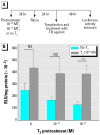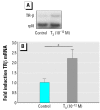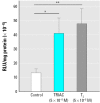A rapid, physiologic protocol for testing transcriptional effects of thyroid-disrupting agents in premetamorphic Xenopus tadpoles
- PMID: 16263516
- PMCID: PMC1310923
- DOI: 10.1289/ehp.7992
A rapid, physiologic protocol for testing transcriptional effects of thyroid-disrupting agents in premetamorphic Xenopus tadpoles
Abstract
Increasing numbers of substances present in the environment are postulated to have endocrine-disrupting effects on vertebrate populations. However, data on disruption of thyroid signaling are fragmentary, particularly at the molecular level. Thyroid hormone (TH; triiodothyronine, T3) acts principally by modulating transcription from target genes; thus, thyroid signaling is particularly amenable to analysis with a transcriptional assay. Also, T3 orchestrates amphibian metamorphosis, thereby providing an exceptional model for identifying thyroid-disrupting chemicals. We combined these two advantages to develop a method for following and quantifying the transcriptional action of T3 in Xenopus laevis tadpoles. This technology provides a means of assessing thyroid activity at the molecular level in a physiologically relevant situation. Moreover, translucent tadpoles are amenable to "on-line" imaging with fluorescent reporter constructs that facilitate in vivo measurement of transcriptional activity. We adapted transgenesis with TH-responsive elements coupled to either luciferase or green fluorescent protein to follow T3-dependent transcription in vivo. To reduce time of exposure and to synchronize responses, we optimized a physiologic pretreatment protocol that induced competence to respond to T3 and thus to assess T3 effects and T3 disruption within 48 hr. This pretreatment protocol was based on a short (24 hr), weak (10(-12) M) pulse of T3 that induced TH receptors, facilitating and synchronizing the transcriptional responses. This protocol was successfully applied to somatic and germinal transgenesis with both reporter systems. Finally, we show that the transcriptional assay allows detection of the thyroid-disrupting activity of environmentally relevant concentrations (10(-8) M) of acetochlor, a persistent herbicide.
Figures






References
-
- Cheek AO, Ide CF, Bollinger JE, Rider CV, McLachlan JA. Alteration of leopard frog (Rana pipiens) metamorphosis by the herbivide acetochlor. Arch Environ Contam Toxicol. 1999;37:70–77. - PubMed
-
- Ciana P, Di Luccio G, Belcredito S, Pollio G, Vegeto E, Tatangelo L, et al. Engineering of a mouse for the in vivo profiling of estrogen receptor activity. Mol Endocrinol. 2001;15:1104–1113. - PubMed
Publication types
MeSH terms
Substances
LinkOut - more resources
Full Text Sources
Other Literature Sources

